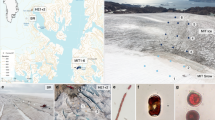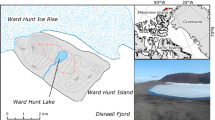Abstract
In aquatic systems, the layer that is suitable for positive net photosynthesis (the euphotic zone) is usually considered to extend from the surface down to the depth of penetration of 1% of the surface irradiance, which corresponds to ∼15 µE m−2s−1 at solar noon during late summer in open waters in the high Arctic1. In polar regions, vernal blooms of epontic algae (unicellular algae associated with the lower interface of sea ice whose photosynthetic characteristics are not well known2–4) develop under conditions where they are only rarely or briefly exposed to light levels exceeding 1–2% of that incident at the surface. I report here that epontic algae from the Canadian Arctic show unusually high photosynthetic efficiencies normalized to pigment content, which increase with a decrease in the light levels at which the populations are growing. Photosynthesis was measurable at light intensities well below ambient (0.01% of surface irradiance). In the most shade-adapted populations5 under deeper snow cover, photosynthesis was optimal at light intensities close to the maximum ambient level, and inhibited at higher intensities. Furthermore, even after almost 2 months of exposure to elevated light levels (≈3–4% of surface irradiance), biomass and productivity normalized to biomass were still lowest in algae from an area almost free of snow cover. Taken together, these results indicate that epontic algae from the high Arctic can be considered as an obligate shade flora genetically constrained to very low photon fluxes.
This is a preview of subscription content, access via your institution
Access options
Subscribe to this journal
Receive 51 print issues and online access
$199.00 per year
only $3.90 per issue
Buy this article
- Purchase on Springer Link
- Instant access to full article PDF
Prices may be subject to local taxes which are calculated during checkout
Similar content being viewed by others
References
Platt, T., Harrison, W. G., Irwin, B., Horne, E. P. & Gallegos, C. L. Deep Sea Res. 29, 1159–1170 (1982).
Apollonio, S. Arctic 14, 197–200 (1961).
Apollonio, S. Arctic 18, 118–122 (1965).
Bunt, J. S. Nature 199, 1255–1257 (1963).
Steemann Nielsen, E. & Jorgensen, E. G. Physiologia Pl. 21, 401–413 (1968).
Alexander, V., Horner, R. & Clasby, R. C. Inst. mar. Sci. Rep. R74-4 (University of Alaska, 1974).
Horner, R. & Schrader, G. C. Arctic 35, 485–503 (1982).
Cross, W. Arctic 35, 13–27 (1982).
Hsiao, S. I. C. Arctic 33, 768–793 (1980).
Lewis, M. R. & Smith, J. C. Mar. Ecol. Prog. Ser. 13, 99–102 (1983).
Holm-Hansen, O., Lorenzen, C. J., Holmes, R. W. & Strickland, J. D. H. J. Cons. Int. Explor. Mer 30, 3–15 (1965).
Platt, T., Gallegos, C. L. & Harrison, W. G. J. mar. Res. 38, 687–701 (1980).
Gallegos, C. L. & Platt, T. Can. Bull. Fish. Aquat. Sci. 210, 103–112 (1981).
Talling, J. F. New Phytol. 56, 133–149 (1957).
Gallegos, C. L., Platt, T., Harrison, W. G. & Irwin, B. Limnol. Oceanogr. 28, 698–708 (1983).
Bunt, J. S. Antarct. Res. Ser. 1, 27–31 (1964).
Bunt, J. S. & Lee, C. C. J. mar. Res. 28, 304–320 (1970).
Palmisano, A. C. & Sullivan, C. W. Polar Biol. 2, 171–177 (1983).
Palmisano, A. C., Soohoo, J. B. & Sullivan, C. W. J. Phycol. (in the press).
Vedernikov, V. I. Oceanology 15, 482–485 (1975).
Richardson, K., Beardall, J. & Raven, J. A. New Phytol. 93, 157–191 (1983).
Fogg, G. E. Phil. Trans. R. Soc. 279, 27–38 (1977).
Palmisano, A. C., White, D. C., Smith, G. A., Stanton, G. R. & Burckle, L. H. J. Phycol. (in the press).
Jacques, G. Polar Biol. 2, 27–33 (1983).
Sullivan, C. W. et al. Antarct. J. U.S. 18, 177–179 (1983).
Radmer, R. J. & Kok, B. in Encyclopedia of Plant Physiology, New Ser. Vol. 5 (eds Trebst, A. & Avron, M.) 125–135 (Springer, Berlin, 1977).
Author information
Authors and Affiliations
Rights and permissions
About this article
Cite this article
Cota, G. Photoadaptation of high Arctic ice algae. Nature 315, 219–222 (1985). https://doi.org/10.1038/315219a0
Received:
Accepted:
Published:
Issue Date:
DOI: https://doi.org/10.1038/315219a0
This article is cited by
-
Identification of the sea ice diatom biomarker IP25 in Arctic benthic macrofauna: direct evidence for a sea ice diatom diet in Arctic heterotrophs
Polar Biology (2012)
-
Spatial and temporal variation of photosynthetic parameters in natural phytoplankton assemblages in the Beaufort Sea, Canadian Arctic
Polar Biology (2011)
-
Photoadaptation of an ice algal community in thin sea ice, Saroma-Ko Lagoon, Hokkaido, Japan
Polar Biology (2009)
-
Denitrification activity and oxygen dynamics in Arctic sea ice
Polar Biology (2008)
-
Identity and physiology of a new psychrophilic eukaryotic green alga, Chlorella sp., strain BI, isolated from a transitory pond near Bratina Island, Antarctica
Extremophiles (2008)
Comments
By submitting a comment you agree to abide by our Terms and Community Guidelines. If you find something abusive or that does not comply with our terms or guidelines please flag it as inappropriate.



